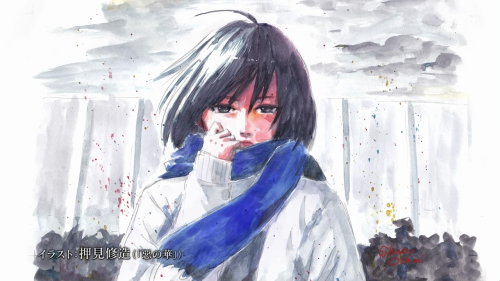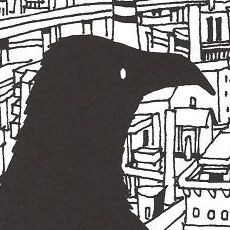This season, I’ve found myself in the fun position of having two of my favourite manga series adapted into anime. We already know how things went with Flowers of Evil, but there’s still the case of Attack on Titan (Shingeki no Kyojin) to consider. Produced at Wit Studio and directed by Tetsurō Araki (of Death Note and Kurozuka, amongst others,) it’s the adaptation I was hoping for back in 2011. So, is it any good? Going by this first episode: hell yes.
After you’ve seen a couple of Araki’s anime, you’ll know what you’re going to get: a bombastic emphasis on action and a sweeping, melodramatic sense of theatre. In other words, he’s great at directing the external, adrenaline-fuelled stuff. I just hope he doesn’t lay it on too thick. In The Lord of the Rings films, director Peter Jackson would often emphasize the horror facing his heroes by slowly panning over the crying faces of children and old ladies, which is very much a blatant “this is some serious shit, guys” trick to pull. It feels too obviously manipulative, and there were signs of that here, too: when the scouting legion returns from a failed mission, there’s a lot of very loud crying. You could always put this down to me being English and all stiff-upper-lip about things. I just find these public displays of emotion to be quite distasteful.
That complaint aside, though, this is pretty much exactly how I wanted the anime for Attack on Titan to turn out. The first few glimpses we get of the 3D maneuver gear are exhilarating and pretty much alone justify its existence: we get to see the scouting legion in action, running through a forest on their horses and coming across a lumbering Titan. The sheer fluidity of their movement as they move from branch to branch, using their gear to swing and pounce, is so beautifully done. You will realise then, at that exact moment, that this series is going to be a keeper.
There’s so much more to Attack on Titan than just action, though, even if it’s as beautiful drawn as that. I’ve already written so much about the manga that I’m at risk of repeating myself here, but at its core this is a story of overcoming life’s greatest obstacles. Put another way, I have this question. By kicking a hole in the wall, are the Titans destroying, or liberating, mankind? Indeed, theirs is a world full of grotesque horror. You couldn’t blame anyone for just wanting to stay safe, but would you be happy living like that? With nothing new to see or do? In its own, clever way, Attack on Titan is set-up as social commentary. A comment by Celeste on a previous post seems particularly apt in this regard: Japan is an island surrounded by walls of water, struggling with high rates of unemployment and suicide.
The city in Attack on Titan may well be a comment on Japan, but it can be applied to any modern, peaceful place where people are able to live such sheltered, uneventful lives. At what point, if ever, do you decide to leave your old ways behind to discover something new? Eren doesn’t have to join the Scouting Legion, but he wants to see the world beyond the walls. There’s a great risk involved in doing that, but unless you try, what’s the point in living?

As an interesting aside, both Flowers of Evil and Attack on Titan are serialised within the same magazine, Bessatsu Shōnen Magazine, and the ending card for this first episode of Attack on Titan is an image of (the extremely cool) Mikasa drawn by Flowers of Evil mangaka Shūzō Oshimi. It boggles the brain to think how cool that little fact is, a bit like when I found out Hideaki Anno and Kunihiko Ikuhara hang out together and talk shit about anime fans. Yes, I’m a nerd.
The anime-fication of Attack on Titan
13 responses to “The anime-fication of Attack on Titan”
-
The only thing I’d note in addition to this is what a clean sweep Kodansha’s manga serials have had in the past 10 years. While Shounen Jump and Ribon, both Sueisha properties, typically defined the manga zeitgeist of a generation (for shounen and shoujo audiences respectively), arguably Kodansha’s properties are attracting much more attention than Sueisha’s newer properties.
In addition to Aku no Hana and Titian in Bessatsu Shounen, Kodansha currently has Chihayafuru running in it’s josei Be Love magazine, Kuragehime in its josei Kiss magazine, a surprisingly not well-documented hit, Yamada-kun and the Seven Witches in its Weekly Shounen Magazine… I could go on. The point is Kodansha’s kicking Sueisha’s ass right now, and that’s a bit of a role reversal to the norm!
Also re: that Ikuhara/Anno conversation. This is also relevant to your post on Aku no Hana, in which Nagahama comments that certain types of manga fans “will be betrayed.” It’s always interesting to see the tensions between a fanbase, a director, and the way a character is portrayed. I’m also reminded of comments the Bokurano director made in regards to the source material – that he “hated it’, as I recall.-
When you think about it, betraying peoples expectations of a story is key to a lot of great fiction. Along side Evangelion, there’s something like Madoka, which belies its horrific nature with a cutesy moe aesthetic. The less predictable a story is, the more interesting it inevitably becomes, and with the sheer level of collateral damage in Attack on Titan, we’re bound for a fascinating watch!
-
Madoka didn’t just cash in on the cutesy, moe asethetic, it built up its own, founded in established norms, before tearing it apart.
Contradiction as an artistic tool depends on expectation, and the more it is used, the less expectation there is.
So it might be said that a good piece of art builds its own norm and then lets the audience experience the glee of tearing it apart before returning to rebuilding the norm or establishing a new one.
I’ve read ahead in the manga, and I like the way it points out society’s tendency to destroy itself from the inside out, but I think it could establish a better rythmn and flow than the manga did, so that its shocking revelations are that much more shocking.
-
-
-
IKU-CHAN?? I AM SO GRATEFUL TO YOU RIGHT NOW.
-
I KNOW RIGHT?
-
-
Knew I had to check this out as soon as I saw, “Kurozuka”.
Keep up the good work! Really glad I found this blog.-
I’m glad you found it, too! 🙂
-
-
[…] Bateszi has been talking about the manga for quite a while, and while I didn’t actually go and read it, his enthusiasm rubbed off on me to the point where I was afraid the anime would be a letdown. Whatever flaws the first episode had (and it has a few), the feeling of fear and powerlessness in face of a terrifying, devastating foe more than makes up for them. This is the story of Eren, a boy living in a city with walls 50 meters tall to keep the giants (titans) out. From the scenes at the beginning and end of the episode you can see why. The giants are nasty, brutish things that seem to wander aimlessly around the countryside eating people. But at the start of of the show there hasn’t been a giant in the city for 100 years. Plenty of time to get complacent. […]
-
Watched it today, and it prompted me to write my second blog post in a day! There’s a hell of a lot to like here, but I liked most the hideous depiction of the giants. They really are scary as hell to look at. (BTW I haven’t read the manga)
If I have any beefs with ep1 it’s with the city population, who behave a little too much like cattle for me to believe it. There have to be more people than Eren and those guys who go outside the walls (and get slaughtered) who want to get out of that place, danger or no danger. Maybe your and Celeste’s metaphors are correct, that’s what the manga artist intended, but cities as a whole don’t lend themselves well as metaphors, unless we’re talking about fairy tales. -
I have this theory that the Titan that killed Eren’s parents is a transformed human. (although i think it’s obvious)
What i wonder though is it a person that he’s already met or not.. -
This is awesome!!
the song of “Attack on Titan” which is from “Shingeki no Kyojin” just released few hours ago in Japan!
and my Japanese whom creators made this one!
They are so talented!
I promise you would love it!!! -
Oh yeah!
Attack on Titan! I will recommend this as well!
It has some cool twists too. 😉 Oh boy. -
This anime has movie adaptation too, but i was really disapointed because the story is different from anime. However its still cool and scary. Lol you should watch it too

Leave a Reply